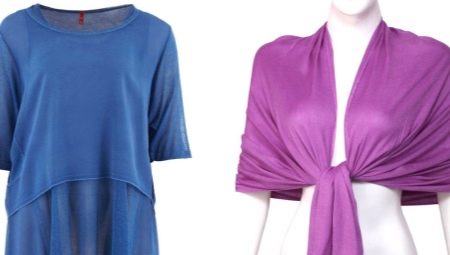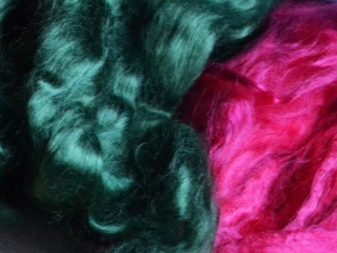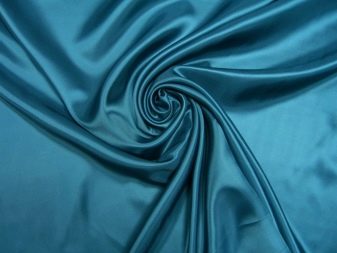Viscose: advantages, disadvantages and scope of use

Viscose is a natural fiber invented by a French scientist at the end of the 19th century. And before him, the material of this type was tried to create by the Englishman Robert Hook. The mass production of the material was launched in the 20th century, it was then that viscose canvas became very popular due to its universal properties.


Natural fabric or not?
The characteristics and properties of the material depend on the production technology. It is produced from wood by splitting it into a cellulosic element - xanthate. And for some time the composition is cooked, reacting with an aqueous solution of calcium.
The resulting homogenized composition is transformed into yarns constituting a viscose fabric. Having slightly changed the technical conditions, polyethylene is produced, therefore viscose is often called natural synthetics. In fact, this is an unnatural fabric made from cellulose.


The main qualities of viscose fiber:
- breathability;
- comfortable fabric texture;
- hypoallergenic;
- smoothness and silky shine;
- lack of the ability to accumulate static electricity;
- resistance to wear and brightness of colors;
- ease of washing and care;
- imitation of natural fabrics: linen, silk and cotton.


In addition, additional properties of viscose fabric are good hygroscopicity, ductility and excellent appearance of products made from it. It is cool to the touch, thin, but quite durable.
The price of the material is made up of the characteristics of the production technology, quality, as well as the manufacturer's costs.Lining viscose costs about 300 rubles, printed (imported crepe) costs 700 rubles, and knitwear costs 900 rubles per running meter.
When buying ready-made viscose clothing, you can check the naturalness of the material, for which you should set fire to several threads. The wood fibers will light up with a bright flame, charred and fall off, leaving the smell of burnt organic matter.


Views
Fabric fibers are classified into silk, staple and cord viscose. Silk is used to sew quilts and bed linen. The staple is used for sewing warm clothes, as well as blankets and carpets are made from it. Cord fabric is used to make luxury clothing. Among other things, the base of the fabric is connected with natural threads of other materials, then the viscose takes on a number of their properties and qualities.



The modern industry of domestic and foreign production produces many types of viscose fabric, we will give their description.
- Natural 100% viscose - synthetics made from bamboo. It is pleasant to the touch, thin and light. When wet, it lends itself to deformation and damage, is not strong enough and short-lived, wears out quickly and loses its properties.
- Lining acetate fabric does not stretch and perfectly protects clothes and hats from getting wet, shrinking and losing their shape.
- Viscose-based jersey - a more durable material, most often used for the manufacture of linen and light clothing.


- Viscose fabric "micro oil “Made with a polyester blend that gives it amazing chic and good fit. Looks elegant in trousers, skirts and dresses.
- Viscose with the addition of elastane and cotton often used for sewing sports equipment.
- With the addition of staple fibers viscose fabric acquires strength properties. Shirts, blouses and outerwear are sewn from such fabric.
- Viscose-silk partially imitates natural fabric, its shine and shine. It is used for sewing pajamas, shirts, as well as home textiles: curtains, bedspreads and bed linen.


Viscose fabrics also differ in name.
- Viscose Tencel similar to cotton, it is made from eucalyptus sawdust, used for sewing curtains, pillowcases, sheets and duvet covers.
- Modal and a thinner micromodal is used for sewing tablecloths, kitchen towels and napkins, as well as hosiery.
- Rayon - a thin fabric with a shine, used for sewing bedding and home clothes.
- Academician - dense knitted fabric, from which heat-resistant linen is sewn.


- Milano - knitted fabric with imitation of wool, from which it is good to sew gloves.
- Siblon - another type of fabric obtained from coniferous sawdust. Thanks to resins and micro-oils, it has an increased strength range in terms of mechanical and physical characteristics.
- Cupra - extra-thin elite extra-class fabric. It is used for sewing expensive outfits. Requires special care, eliminating string and ironing.


Blended viscose with polyester content is used for sewing inexpensive garments. The domestic market is dominated by imported viscose made in China, as well as finished products from Uzbekistan.
The variety and combination of varieties of viscose fabric makes it a versatile material used for sewing clothes for various purposes and properties. In addition, the same diversity allows the consumer to pick up material with any financial situation.

How is it produced?
As you already know, viscose is made from cellulose - a wood product that serves as a raw material for fabrics. The complex manufacturing process consists of multi-stage production steps during which the wood fibers are chemically treated. Since the invention of the material, the technology has not changed, only the equipment has been reconstructed. Basically, these are four stages of production.
- At the first stage, the basis of the future fabric is formed. The wood blocks are crushed to shavings and boiled in large cauldrons with caustic alkali.
- On the second, threads are made by passing the resulting mass through a special sieve with many small holes.
- At the third stage, finishing is carried out, including painting and drying the product.
The viscose fabric made in this way is formed into briquettes, which then end up on store shelves or in sewing shops and workshops.


Advantages and disadvantages
The advantages of viscose fabric include the following points:
- feature to warm in the cold season and cool in winter;
- thanks to the pleasant heat-sensitive texture of the fabric, the products are very comfortable and cozy;
- fabric fibers give good adhesion to color pigments, as a result of which it is well dyed, creating various color variations;
- weightlessness and soft absorbent properties expand the scope of the fabric in any climatic zone;
- matte, as if luminous surface of the fabric can be easily draped, creating beautiful elements of clothing and interior;
- dress viscose is very comfortable to wear and unpretentious to care for.


The features of viscose fabrics can also include the ability to stretch when wet and shrink when washing. At the same time, 100% viscose can be strongly tightened when worn, and often things made from it quickly lose their shape and wear out. But this only happens with improper care. Pure viscose is capable of crumbling heavily during sewing, so the cut elements require additional processing. Fabric with polyesters can stretch a lot, which is very good for linen, but not applicable for outerwear and formal dresses.
Viscose with additives acquires their properties. For example, cotton gives it softness, staple - strength and heat resistance, artificial silk - smoothness and shine. She, like all natural fabrics, practically does not burn, so it can be safely attributed to fire-resistant materials.
New modifications of viscose fibers allow the material to be used in almost all household areas and not only.


If we look at customer reviews, there are several facts that can be highlighted.
- Viscose with added wool extremely warm and comfortable to wear, stretches well and does not accumulate static electricity, besides, things made from it are affordable.
- Modal fabric much lighter and cheaper than its eucalyptus counterpart, which, in turn, makes it more popular among buyers. This is due to the simplified production technology, which significantly reduces the costs of the manufacturer, which affect the initial price of the fabric.
- Viscose "micro-oil" and "oil" gives a comfortable close-fitting effect to things sewn from it. The cut of elements of this type is very different from similar patterns from other fabrics, since it is possible to remove unnecessary darts and folds, which are usually used for a good fit on the figure.


- Viscose lining breathes well and perfectly keeps the shape of coats, suits and outerwear. Therefore, it is the most popular among lining fabrics.
- Sewing expensive outfits from cupra it is better to entrust it to professionals due to the specificity of the fabric, expressed in special subtlety and a number of properties that make it the most delicate and beautiful of all fabrics in this line.
Before cutting and sewing, the viscose fabric should be washed and dried so that the finished product does not shrink after the first wash.

Comparison with other fabrics
If we talk about comparing viscose with other fabrics, then special attention should be paid to its versatility. Cotton and linen are hygroscopic and therefore good in the bathroom. They are used for sewing towels, bathrobes, slippers and other similar paraphernalia.
But from linen and cotton it will not work to sew a coat or jacket.Theoretically, this is possible, but given that linen and cotton are purely natural materials, the use of things sewn from them in the usual way becomes impossible. Clean materials, being exposed to atmospheric precipitation and other factors, will quickly fail and wear out.

At the same time, the versatility of viscose extends to children's clothing. Stylish and safe children's suits made of it are very popular among buyers. Parents are happy to dress up their little princesses in colorful dresses with multi-colored flowing frills and bows. But only viscose fabrics can give such an elegant effect, therefore they are also widely used for sewing holiday and New Year's costumes.
Viscose is also irreplaceable in the interior. Woolen curtains or drape rugs are hard to imagine. It will be very costly to "dress" furniture in pure satin, jacquard or silk, printed velvet and crepe are not applicable for bed linen.
For home textiles, there is nothing better than viscose. It combines the best properties of natural and synthetic fabrics and fully meets the needs of consumers.


Application
Basically, clothes and various things are sewn from viscose - from underwear and bed linen to outerwear. But it is also successfully used in household use as upholstery of furniture, household textiles. With its help, you can create any style in interior design. Viscose fabric takes on a special sound on the walls. Thanks to it, with appropriate lighting, a cozy atmosphere is created and style is maintained.
Decor elements in the room, as well as household items upholstered in viscose fabric, become real works of art, favorably emphasize the style and taste of the owners of the house.


Care advice
Viscose clothing should be washed with extreme caution, as it is prone to constriction and deformation when wet. Hand wash can be replaced with a delicate cycle in a washing machine, at a temperature not exceeding 30 degrees Celsius. For washing, it is best to use soft water and a phosphate-free powder. Ideal elixirs for special fabrics that retain the elasticity and color of the fibers during washing. In addition, some of them also function as a conditioner and rinse aid, which provides additional care for the product and contributes to long-term wear.
It is better to completely exclude the spinning of washed things so that they do not lose their shape. It is best, after the water has drained, leave them on a terry towel or other soft cloth to soak in, and then hang them for final drying on hangers or special stands for drying such things.
In no case should you dry viscose clothes on radiators and other heating devices, otherwise the internal structure of their fabric will simply burn out.


It is not recommended to iron viscose clothes; it is also impossible to steam them in a horizontal position. Some people use an iron in tulle and silk mode. But it would be more correct to use a steam generator. It neatly, easily and quickly straightens the fibers of the fabric without the risk of burning them.
We hope that the information from the article will open up a lot of new things, help you decide on the choice of a suitable viscose material, and also tell you how to properly care for things made of this multifunctional fabric.


For what viscose is, see the next video.








